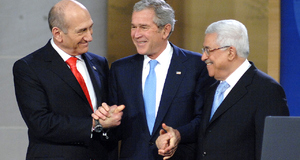Israel and Palestine: An E.U. Model For Peace
By
2011, Vol. 3 No. 06 | pg. 1/1
KEYWORDS:
The Israeli-Palestinian conflict is a perplexing problem that weighs heavily on the world. For over seventy-five years, blood has been spilt over a piece of land about the size of New Jersey. Numerous attempts have been made to find peace in what is referred to as the Holy Land. Unfortunately, each plan has failed miserably. What is needed now is a fresh examination of the circumstances. Divergent ideas need to be brought to the table for examination and discussion. The overall idea of any peace solution should be to find a way where two different people can co-exist with stability and opportunity. With this theme in mind, it may be fruitful to propose a plan that weighs in on a solution that can be economically beneficial. After all, a successful economy with plenty of opportunities may be a viable technique to alleviate fear, foster hope, and help heal the wounds of the past. A possible solution to this conflict may lie in establishing a two state economic union based on exploiting economic strengths in the hopes of creating a relationship of mutual success. It is prudent to have a history of the Israeli-Palestinian conflict to arrive at an informed solution. The history of the conflict can be said to have its roots in the expulsion of the Jews by the Roman Empire in 70 CE. For nearly two thousand years, the majority of the Jewish people languished under governments that viewed them as foreigners. The idea of Jews returning to the Levant finally had a strong voice in the nineteenth century movement of Zionism, a secular movement with the aim of establishing a Jewish homeland. During WWI, the British, willing to guarantee support for a Jewish homeland in exchange for monetary aid, forged the Balfour Agreement, which was seen as a major victory for the Zionist movement. It wasn't until the Holocaust, however, that Zionism had an undeniably strong case. The atrocity proved that there was a deep current of anti-Semitism in Europe, and the only solution was to return the Jewish people to their ancient homeland of Israel. What the U.N. did not seem to take into account was the voices of the Palestinians, who were already inhabiting the land. The result was the 1948 war, which the Israelis considered a war of independence, but the Palestinians considered it a nahkba, or catastrophe (Tolan xvii). The end of the war saw the Palestinians reduced to the status of refugees. Major bloodshed started back up in the 1967 Six Day War. A surprise attack by Israel consolidated their power in the region, taking over the West Bank and Gaza. The takeover initiated the start of Israeli occupation and settlement of the remaining Palestinian lands. The deplorable use of terrorist tactics by the Palestinians were a direct reaction to an overwhelming Israeli occupying force in the West Bank and Gaza.Brutality from both sides continued throughout the late 1980s during the First Intifada. The First Intifada ended with the Oslo Accords, which gave the world hope that peace could finally be achieved. Peace, however, was a fleeting dream with the outbreak of the Second Intifada in 2000. Since then, violence has continued in varying degrees, as Palestinians continued to resist by any means necessary, and the Israelis have continued their settlement projects, particularly in the West Bank. The borders that would be the markers of the standard two state solution are not conducive to a meaningful peace plan. One problem is the fact that the Palestinian State is divided into two territories separated by a nation that continuously impedes unity. It is a monumental task to move within the West Bank, but nearly impossible to move between the two territories. Another problem with the borders is that it stifles any future Palestinian economy. The Palestinian State is currently locked in, ensuring that Israel is ultimately in charge of the economic well-being. The only outlet is Jordan, who has shown hostility to Palestinians in the past. Israel has proved that it has the ability and intention of abusing its power as evidenced by Palestine's forty-six percent poverty rate in the West Bank(West Bank). Israel's abuse of power is also shown by its blockade of Gaza, which has resulted in widespread poverty and low quality of living standard(Roy). This has also created a dependency on donation aid, which is never a viable source of a national budget. Palestine must be cultivated for economic success by uniting Gaza and the West Bank, while forcing an Israeli stand down of occupation and naval blockade. This will result in a united Palestine that would have the ability to access the sea for trade that is not completely reliant on the goodwill of Israel. The idea of a one state solution that would create a united nation of Israelis and Palestinians is a plausible idea that if refined could provide an alternative to the international consensus. One sizable problem to a unified state is the question of what type of democracy would be enacted. A democracy that drives it's legislative power from a majority of differing peoples will result in Jewish-Israeli loss of domination. This is a real fear that is present in the modern Israeli collective that is evidenced by the writings of Mordechai Nisan, a professor of Middle Eastern studies in Jerusalem(268). A solvent for this dilemma is to create a confederacy with limited equal seating. The power would be divided equally in theory among Palestinians and Israelis. The main problem with this theory is that it would only solve legislative problems. There are still a wide variety of social problems that need to be addressed. The most extreme would be "...the extermination or expulsion of an indigenous people" asserts Professor Emeritus Noam Chomsky (16). Less extreme dilemmas would be similar to ethnic problems in the United States, such as redlining of residential properties, preferences for higher education,criminal racial profiling, or even worse. As these types of social problems plague the U.S. and other nations around the world, a two state solution is pragmatically superior. The two state economic union solution is a mixture of the best qualities of the singular state and two state ideas. Two states would enable both sides to exercise self determination. An economic union will promote trade cooperation and incentive for both sides to succeed together. The foundation and driving force of this concept is the goal mutual economic success. An economic union model as it applies to the Israeli-Palestinian situation would first call for the unification of Gaza and the West Bank for reasons already discussed. Anything less than an actual geographic unification would invalidate the spirit of the concept. The Palestinians need to have a secure way to transport goods and labor between the two territories without being inhibited or interfering in Israeli affairs. The second task of the economic union model that once two states are established, a new unifying currency needs to be developed and established. The currency in use throughout Israel and the occupied Palestinian territories is the Israeli Shekel. Although it would be less taxing on the population and the the two nation's economies, the use of the shekel in occupied territories is also a symbol of Israeli domination. It would prove better in the long term to form a new singular currency to erase any prejudice of Israeli imperialism and make a statement of equality. The third main task of the economic union model would be the establishment of Jerusalem as an independent city-state. The city-state would have to draw up a U.N. approved constitution that would promote and protect religious diversity in a city that is holy to the three major monotheistic faiths. The city-state could also house a headquarters for the economic union, where both states could meet and administer the union from a city that both sides revere. The fulfillment of these three main task would be a breakthrough for relations between both sides of the conflict, and it's implementation is not far fetched. Even critics who would point to stumbling blocks such as Hamas would do well to take note of of former U.S. President Jimmy Carter's assessment of Hamas, concluding that even they would be willing to seek a two state agreement (163). In order to seriously make an effort to any sort of peace, both sides have to make some key ideological sacrifices. For the Israelis, they must sacrifice the idea of Greater Israel. This idea is the a motivation, recognized or not, behind the Israeli settlement movement. The Israelis must respect the national identity of the Palestinians and they must completely withdraw their military, as well as their settlers in order to move to peace. The Israelis must also tear down the wall that encloses Palestine. The wall stands as a monument to fear. A unified act of tearing down the wall, as seen in the Berlin wall, may unify the two people. For the Palestinians, they have to sacrifice the idea that the whole land will once again be theirs. They may argue that they simply want to return to their former homes, but the underlying statement is that those who hold those views desire the land to be theirs. This idea also entails not recognizing the state of Israel and the right to have a homeland that is tied to the Jewish identity. The fact of the matter is that Israel exists, and will continue to exist with Western support. The Israeli-Palestinian conflict is not an easy problem to contemplate, let alone attempt to actually solve. There are plenty of points in this proposal that need refinement. A more thorough discussion of economic theory, especially in the field of multi-state unions, will help refine this solution. Continued investigation into how Israel and Palestine could work together economically, especially in the service industry would also contribute to a meaningful breakthrough. The important thing to keep in mind is when examining this issue, one must keep a divergent mind and keep searching for creative ways to build peace. References Carter, Jimmy. Palestine: Peace Not Apartheid. 2006. New York: Simon & Schuster. Print. Chomsky, Noam and Ilan Pappe. Gaza in Crisis: Reflections of Israel's War Against the Palestinians. 2010. Chicago: Haymarket. Print. Nisan, Mordechai. Minorities in the Middle East: A History of Struggle and Self-Expression. 2002. Jefferson: McFarland and Company. Print. Roy, Sarah. "Economy of Gaza." Counterpunch. Out of Bounds Magazine. Web. 7 Mar 2011. Tolan, Sandy. The Lemon Tree: An Arab, A Jew, and the Heart of the Middle East. 2006. New York: Bloomsbury USA. Print. "West Bank." The World Factbook. CIA. Web. 7 Mar 2011. Suggested Reading from Inquiries Journal
Inquiries Journal provides undergraduate and graduate students around the world a platform for the wide dissemination of academic work over a range of core disciplines. Representing the work of students from hundreds of institutions around the globe, Inquiries Journal's large database of academic articles is completely free. Learn more | Blog | Submit Latest in Political Science |
















